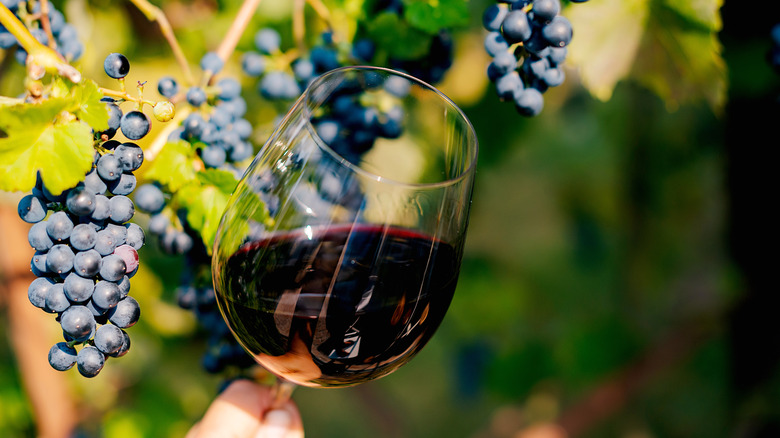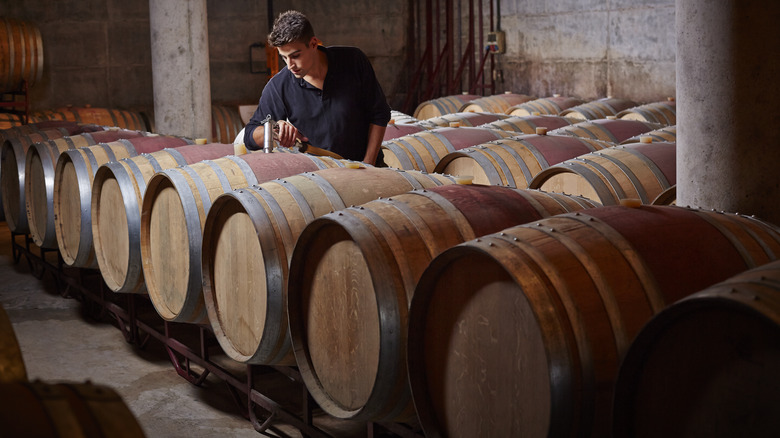What Exactly Are Tannins And How Do They Impact Your Wine?
If you've ever left a teabag soaking too long or eaten a thick-skinned grape and wondered about the sharp, grassy sensation interfering with the sweetness, you're familiar with tannins. Named for the process of tanning leather hides, tannins are one of hundreds of chemical compounds known as phenols that are found in wine (and chocolate and tea). They affect the flavor, structure, and ageability of the drink. Particularly significant in red varietals, tannins are responsible for the dryness (or pucker factor) of the wine on your palate and can influence the bitter and astringent notes crucial for pairing with certain foods.
Scientists have been studying tannins and other polyphenolic compounds in wine for at least a century. But they're only beginning to understand how our brains interpret the associated levels of bitterness (one of the five tastes the tongue actually perceives) and astringency (a gustatory sensation connected with memory and experience). When it comes to tannins, sommeliers have noted anecdotally that different cultures perceive tannic strength differently, perhaps due in part to how many bitter and astringent foods are in their regional diets. So, being raised on rhubarb and strong tea versus mashed potatoes and milk might impact how you perceive a tannic Italian Barolo.
This is only the tip of the viticultural iceberg when it comes to tannins. Next to the miracle that is converting sugar into alcohol through fermentation, the presence or absence of tannins and how they're managed may be the most significant elements in creating delicious wines. Here's the story.
Defining wine tannins
There are two natural sources of tannins in wine: grapes and oak. Most of a grape's tannins (known as condensed tannins) are in its skin, pulp, and stems, rather than its juice. The longer grape juice comes in contact with skin and other bits and pieces during fermentation, the more tannins will infuse the liquid. The color in red wine comes from lengthy skin contact, while the juice for white wines is generally removed from the skins before or during fermentation. Hence red wine has the higher tannin content (which also differs for each grape varietal).
Oak also contains tannins, called hydrolyzed tannins. When wine is stored in barrels, the wood expands and contracts as temperatures change, imparting tannins, esters, and polymers into the liquid, influencing the final product. Species of oak growing in different regions — France, Spain, Hungary, the United States — impart distinct flavors to wines as they age, and barrels used over and over will impart fewer tannins and other phenols to the wine.
Tannin powder, a natural additive created from grapes, is sometimes added during the barrel aging process, as are oak chips. Both speed up the rate tannins infuse the wine. It's often done to save money and time, while producing a full-bodied, well-structured finished product. While it may seem like cheating, it's a perfectly acceptable process.
How they're used in winemaking
The ability of a winemaker or cellar master to manipulate and regulate tannin content in wine verges on quantum mechanics. Both the length of time the drink spends in contact with grape skin and the amount of rind present is important. So is the decision to ferment whole grape clusters or filter out the solid bits. Thick-skinned grapes like cabernet sauvignon or malbec have higher natural tannins than thin-skinned grapes like pinot noir or Gamay (Beaujolais). Tannins in thin-skinned reds can be further manipulated and softened through a process called carbonic maceration. Even growing conditions affect tannin content: Cooler temperatures can produce "greener" tannins — less sugar and more astringency — than the same grape varietal grown in hotter climates.
When it's time for aging, employing a mix of barrels — perhaps French and American, new and previously used oak, or oak and non-interactive steel —determines how much the wood will influence the finished wine blend. As wine ages (either in the barrel or bottle), tannins begin to connect, creating longer and longer chemical chains. The effect is to "soften" the bitter tannins and develop a rounder wine. You'll experience a more coherent structure (the character of the wine) and a velvety mouthfeel. Since red wines are high in tannins, they tend to respond best to barrel aging, where they will continue to evolve and mature (though some chardonnays and other whites can benefit from a brief use of the process). Tannins also act as a natural preservative, which is ideal for long-term storage of your favorite vino.
How to interpret tannins in your drink
Read enough wine labels and you'll discover tannins described as light, powdery, velvety, integrated, silky, oaky, green, and a host of other flowery descriptors. In general, they outline how tannins impact your experience with the wine (in conjunction with its alcohol content, acid level, aromas, and flavors). A white or light red wine presenting soft tannins will feel fruity and refreshing. A red wine with young or unstructured tannins may come off as too brash, with too much "pucker," and need more time in the bottle before enjoying it. A well-balanced tannic red might be bold, round, or full-bodied.
Many sommeliers say they can differentiate between grape and oak tannins based on what part of the mouth dries out. Tingling lips and gums indicate grape biomolecules, while oak types impact the tongue and soft palate and sometimes dry out a wine's finish. As a drink ages significantly (say, 20 or more years), tannins and other components from the oak can fall out of solution, leaving sediment in the bottle. This is an ideal situation for a wine decanter.
Understanding how tannins function isn't simply about the composition of a given bottle. They also bond with proteins, which is why bold red wines pair so nicely with fatty steaks — the tannins actually act to cleanse your palate and enhance your meal. Understanding them can also help you avoid common mistakes when pairing your drink with salmon and how best to store reds for the long term.



